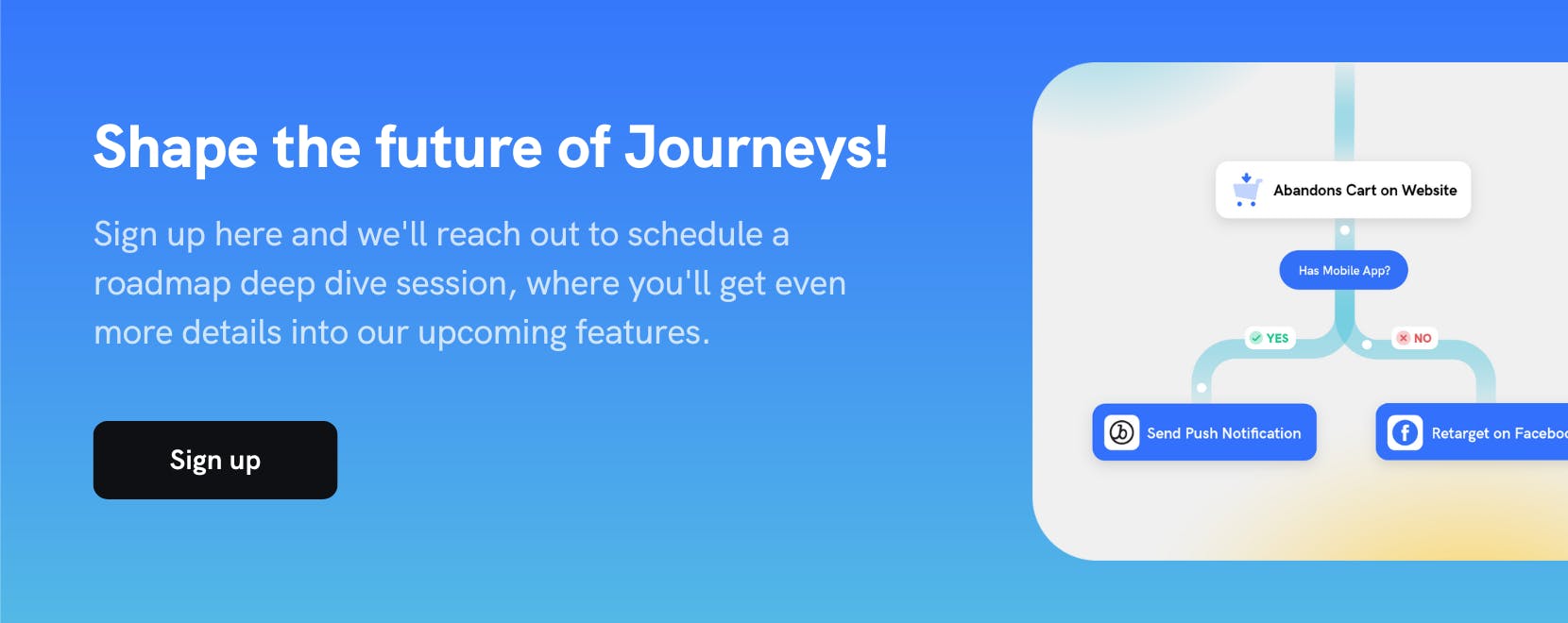An inside look in mParticle Journeys roadmap themes and initiatives
In this article, we break down the four themes of the mParticle Journeys product–testing and experimentation, analytics, orchestration, and experience delivery–and explain how you can get involved in shaping the future of Journeys features.

Early in 2022, we announced the beta release of Journeys, a holistic solution for creating optimized cross-channel and multi-touchpoint customer experiences.
This post will outline the four key themes of our product roadmap for Journeys, providing some examples on how we plan to translate these themes into actual features as we progress Journeys from beta to GA.
Though we’re excited to share what we have in store for Journeys, we recognize that the feature will only be a success if it’s valuable to you, the user. And that’s why we also want to take this opportunity to collect your input on what we’re building.
As you read, click the banner at any time and sign up to:
- Chat directly with our product team and product managers
- Get more details about our roadmap and see specific examples
- Give input on how we invest, prioritize, or describe features
What is Journeys?
Customer journeys today span multiple channels and touchpoints, from mobile apps to emails, from connected TV to SMS. While multi-channel journeys have given consumers unprecedented levels of flexibility when engaging with brands, they’ve also created a headache for marketing teams who want to provide both a consistent and personalized experience across these surfaces.
Even if teams were able to heroically craft a personalized cross-channel experience, it’s often difficult to continuously monitor and tweak those experiences as customer behavior or structural factors change.
Journeys by mParticle helps marketers and product managers not only orchestrate amazing experiences, but also get insights into journey performance and run experiments. With the ability to test, analyze, and orchestrate in a single platform,brands can continuously track and tweak journeys to deliver the most optimized experience.
Learn more about mParticle Journeys features here.
Theme 1: Testing and Experimentation
One of the most important parts of optimizing digital experiences is testing and experimenting. You can even make the argument that you won’t KNOW campaigns or experiences are optimized unless you’ve compared them against alternatives.
We plan to enable users to run complex ABn and multivariate experiments within the main Journey Builder interface. When combined with complex path controls, brands can actually run two entirely different kinds of experiments.
First, brands can compare different engagement channels and touchpoints at a single moment in the customer journey. For example, let’s say that an eCommerce brand wants to deliver an experience when a customer abandons their cart, in order to drive sales.
At that moment, a brand can send an Audience of users who have abandoned their cart to an Audience partner, who will ultimately deliver the last mile engagement. These partners represent different channels and touchpoints: Braze representing email or push notifications and Facebook representing social media ads. With Journey Experimentation, brands can compare two different engagement channels at a single moment in the customer journey. Specifically, you’ll be able to analyze each channel’s impact on subsequent Milestones and on a journey’s goal.
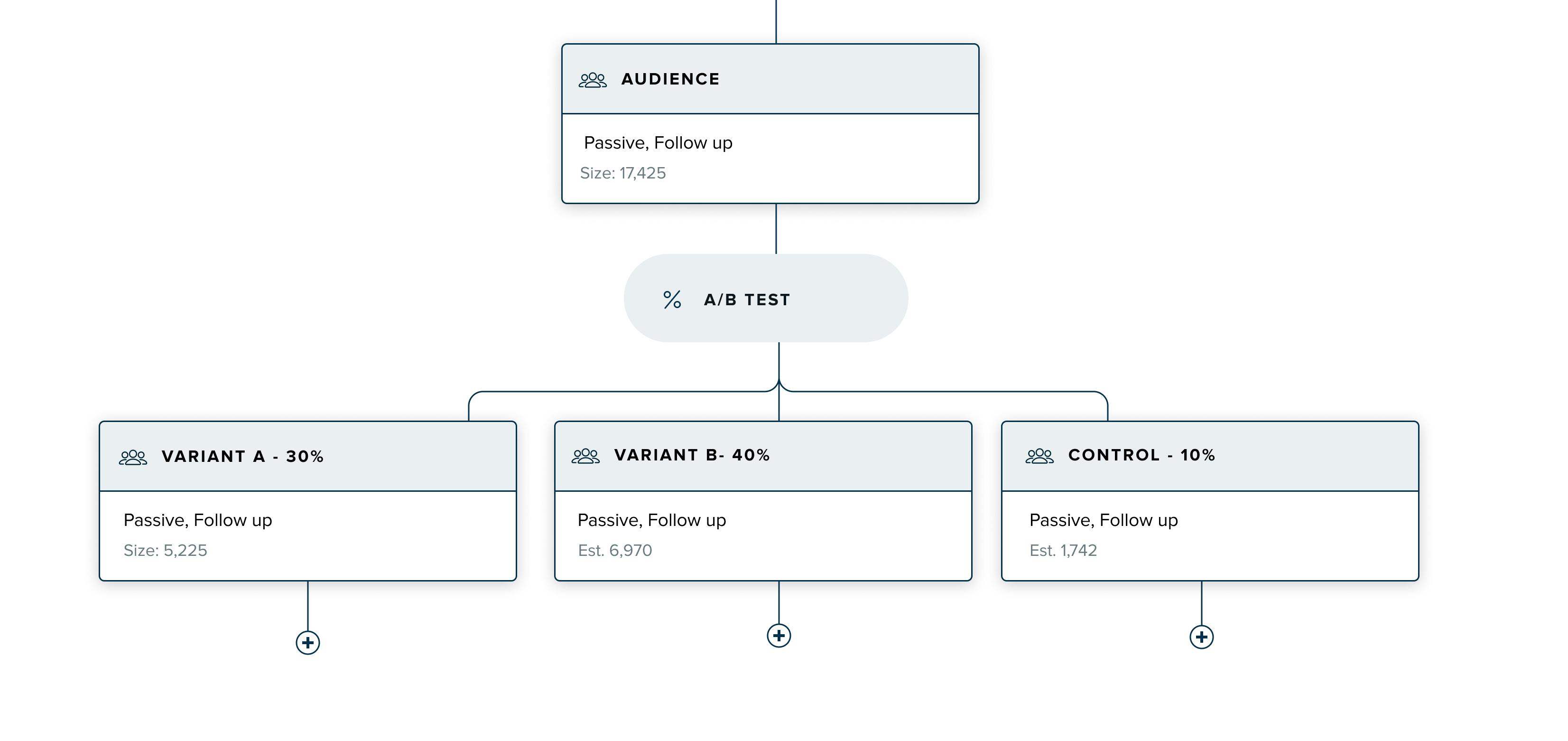
The second kind of experiment leverages the unique aspect of Journeys, which is the targeting and orchestration of successive touchpoints in the customer journey. Instead of comparing two engagement channels at one moment in the journey, brands can instead compare a series of different engagements across channels and touchpoints, and see which combination of cross-channel experiences drives conversion goals.
We’re aiming to make the experiences of creating these experiments seamless, but also to make the analysis of the experiments’ impact easy.
Theme 2: Journey Analytics
Speaking of reporting, our second roadmap theme revolves around journey analytics.
We’re thinking about journey analytics with three goals in mind:
- Showcase overall journey performance
- Enable optimization
- Showcase the impact on key goals
As such, we’re thinking about three rather specific ways to achieve those goals.
The first way we plan to achieve these goals is to showcase a journey’s impact on a defined goal, showing the potential uplift in conversion or engagement. We’ll also show how users flow throughout the journey by demonstrating the conversion rate of users from Milestone to Milestone. Teams can use the information presented to identify customer touchpoints that see high user drop-off rates, and then tweak the journey or engagement strategies accordingly.
In the spirit of optimization, we also plan to deliver experiment and test results, demonstrating how variants are impacting the overall journey goal, and how that impact compares to a control group. We’ll also endeavor to showcase the experiment’s impact on the journey steps prior to the goal. With this insight, users can optimize the journey by picking the winning variant or changing the overall journey structure.
With users making continuous optimizations, teams will want to know how a journey performs over time, incorporating all of the updates in that time period. More importantly, teams will want to know how the optimizations change performance, relative to specific prior versions of the journey. This insight will enable teams to report on their incremental contribution to business impact.
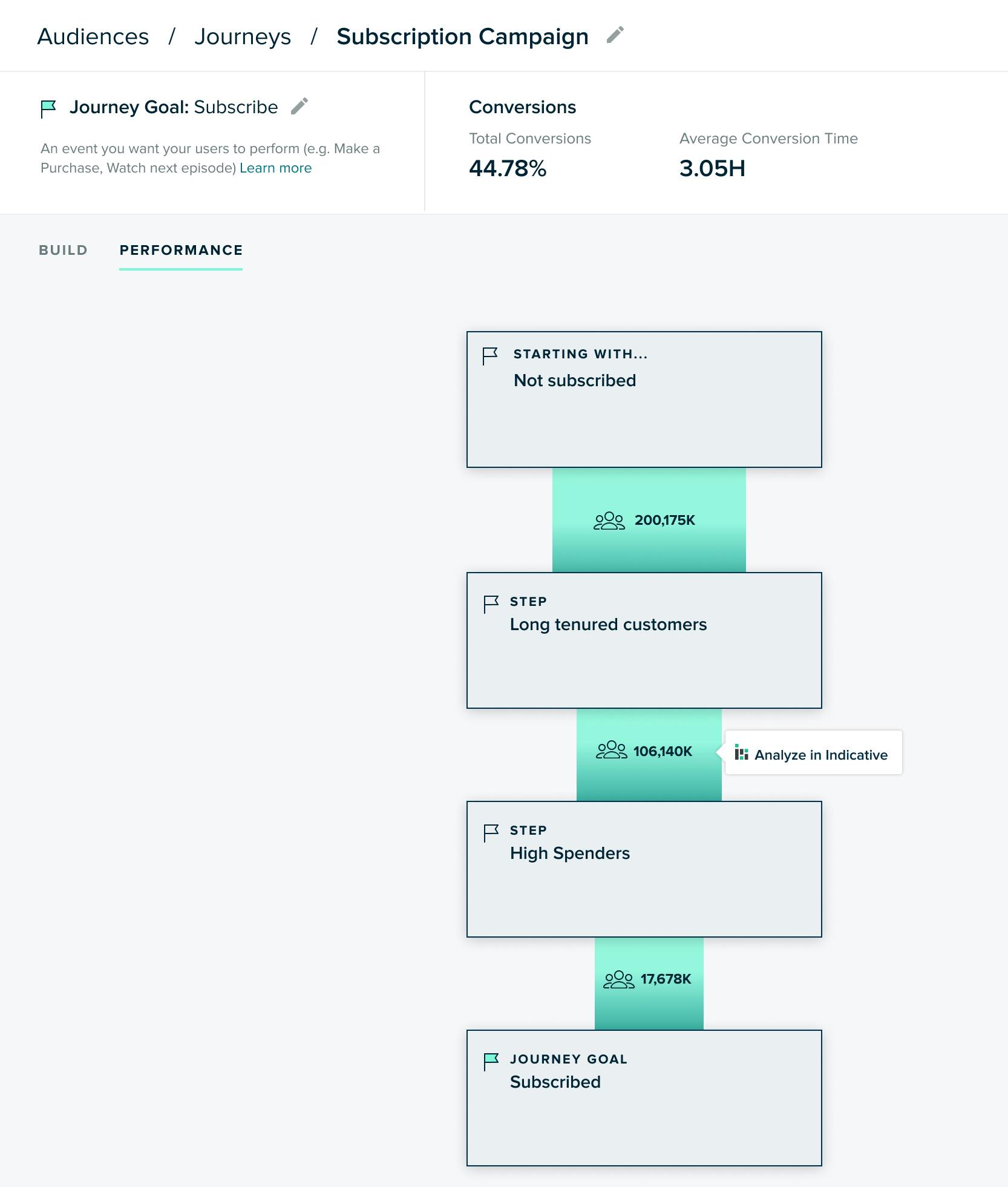
Theme 3: Complex Journey Orchestration
Customer journeys are complex.
They span channels and devices, but also stretch out across time. Multiply the number of actions a consumer can take within an app by the wide variety of customer segments, and you can see an almost infinite number of paths to conversion.
Addressing this complexity is the third theme of Journeys: we aim to give brands the tools they need to map journeys that are as nuanced as the ones their customers actually take.
With this mandate in mind, we plan on including the ability to:
- Create multiple paths/branches, based on event and user data
- Control the timing and order of how users flow from Milestone to Milestone, thereby controlling the timing and order of experience delivery
- End journeys with the start of another one, and vice versa
We consider these functionalities table stakes in helping brands deliver personalized experiences. For example, for a common journey, like an eCommerce path to purchase, a growth marketer might want to split a journey into two branches, giving customers with high lifetime value a different set of experiences than those with low LTV.
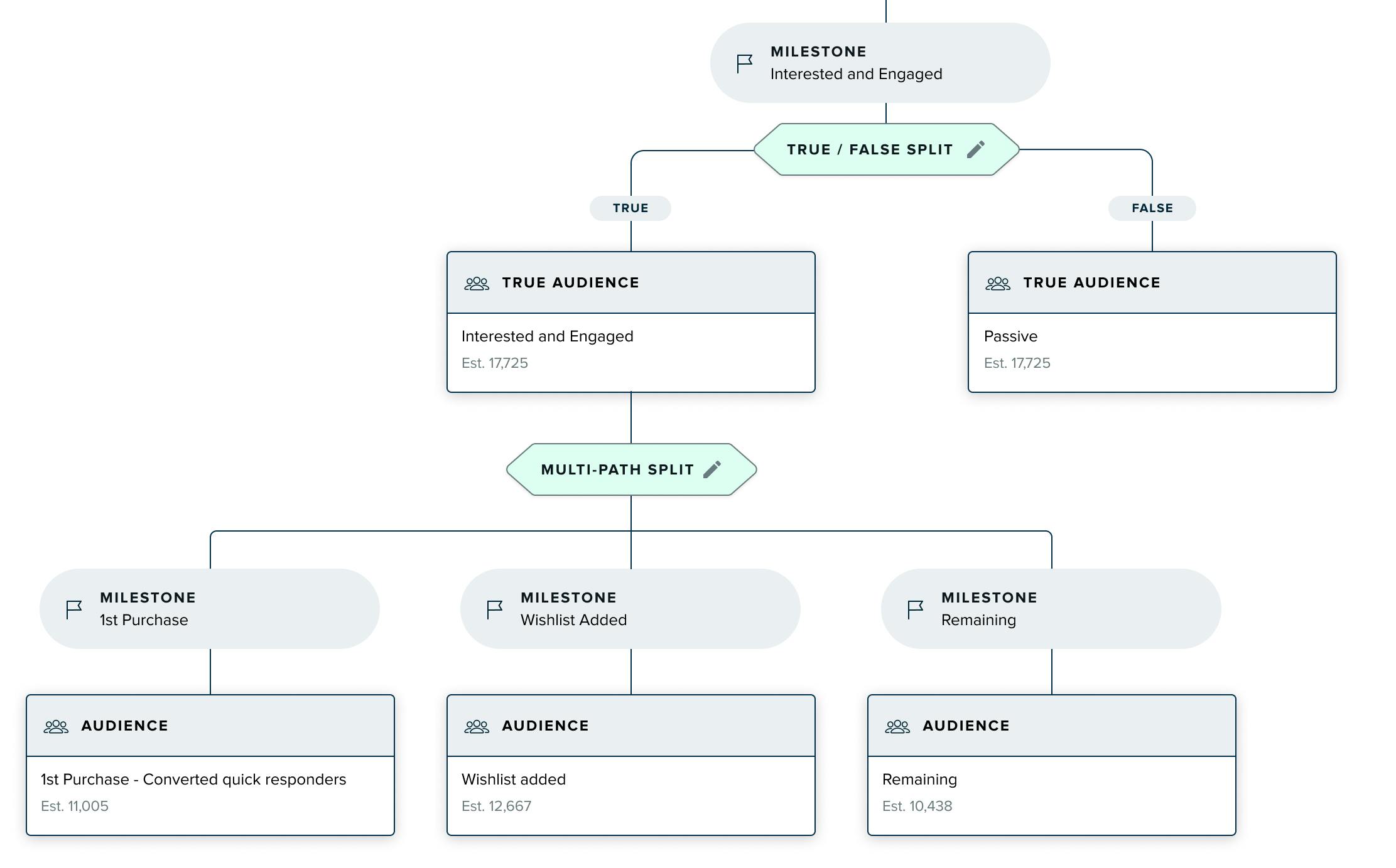
We’d love to hear from you about other kinds of journey controls you would like to deploy when orchestrating amazing cross-channel experiences!
One way we are thinking about orchestration control is to consider the unique value of building journeys in an infrastructure-layer Customer Data Platform as opposed to building them in a marketing platform such as Dynamic Yield or Iterable.
Fundamentally, mParticle Journey Builder powers cross-channel experiences by orchestrating the flow of customer data. Along these lines, one example of a unique orchestration control could be creating different journey paths based on a user’s privacy preferences.
Today, mParticle collects and maintains a range of user consents for privacy laws, like the General Data Protection Regulation (GDPR), the California Consumer Privacy Act (CCPA), and Brazil LGPD. Based on a the status of user consent for one of these laws, a brand might want to engage the customer differently, or not at all, at a particular moment in the customer journey.
Let us know of other kinds of CDP-specific orchestration controls that you’d like to see!
Theme 4: Experience Delivery at Scale
Our last theme aims to make the creation, building, and optimization of journeys easy, such that teams can scale up the velocity and quality of experience delivery .
To support scalability, we’re working on a range of usability, performance, and overall quality-of-life features. In addition, we endeavor to remove any possible cost barriers and reduce time to value.
In the name of reducing time to value, we’ve already released one feature called Audience Estimator. Audience Estimator gives mParticle users instant feedback on the quality and size of the criteria they use to build Audiences and Milestones.
Audience Estimator is even more valuable within Journeys, as it reveals the estimated number of users progressing from Milestone to Milestone, highlighting potential areas of high user drop off. This instant insight helps journey builders quickly adjust targeting strategy, and hence, deliver more customer experiences.
We know that creating customer experiences is a process, with many stakeholders and requirements that need to be addressed throughout. Our goal is to make this process easier. Let us know how you’re building customer journeys today and we’ll build the features you need to scale up customer experiences!
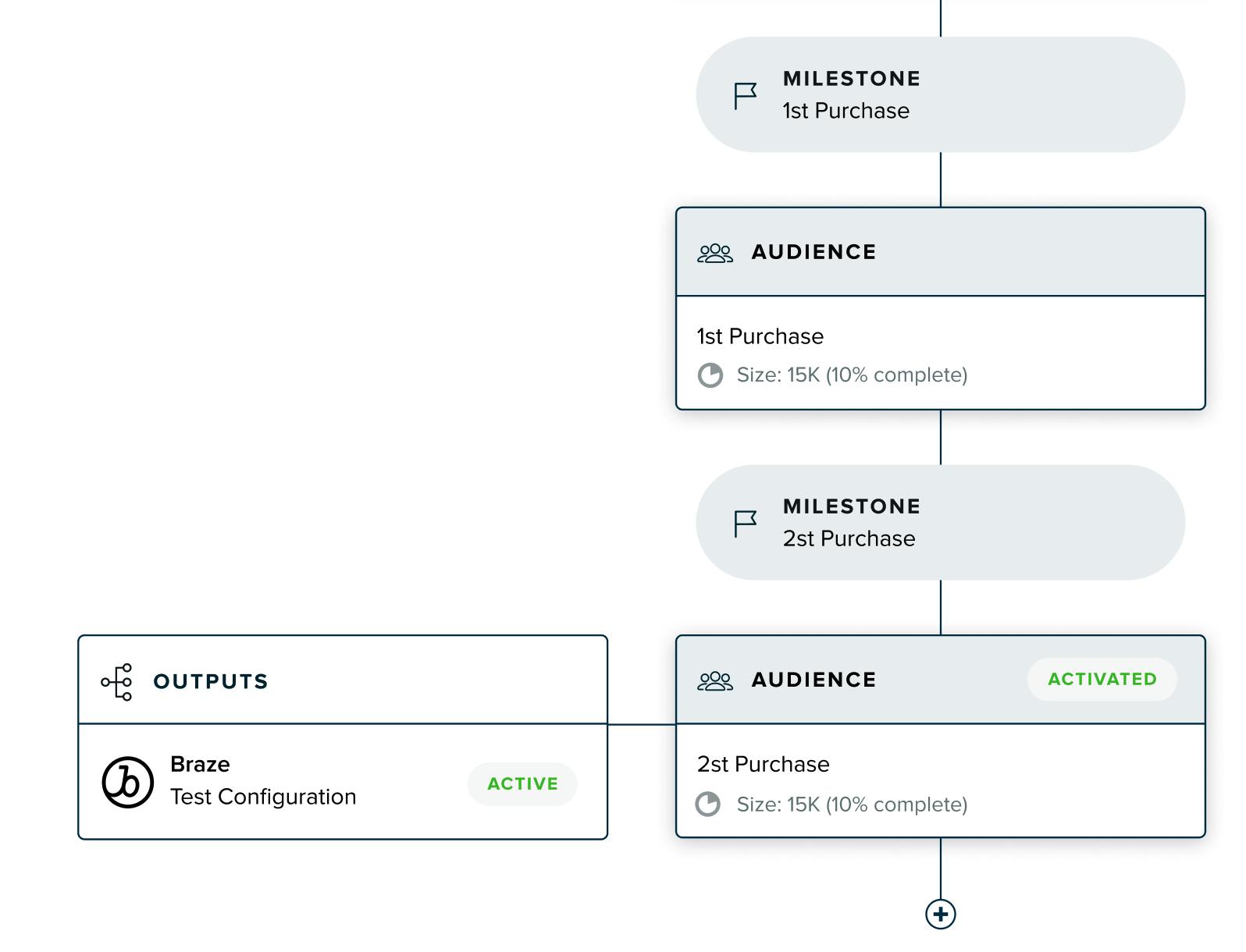
To learn more about mParticle Journeys, you can watch the product webinar here, which features an in-depth product demo and a look into the Journeys product roadmap.
